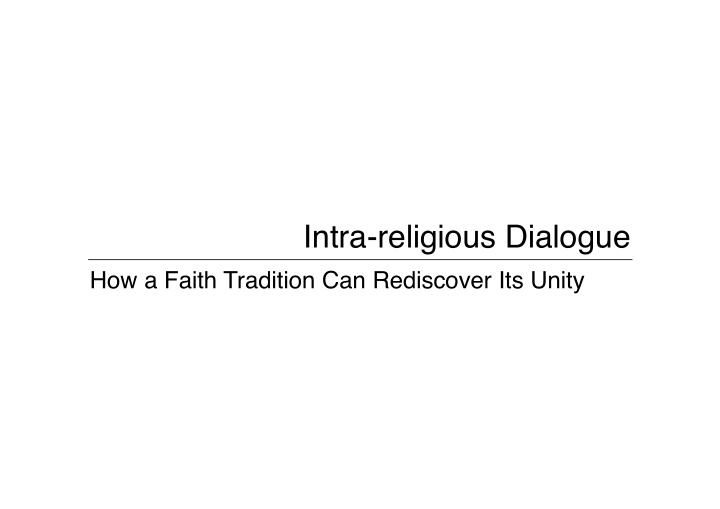



Intra-religious Dialogue How a Faith Tradition Can Rediscover Its Unity
Intra-religious Dialogue 1 Healing memory 2 Europe: continent of war? 3 For all humanity 4 Identity in sensibility 5 Fullness still ahead 6 The gift of the other 7 The pain of the other 8 Differentiated Consensus 9 Face – side – back 10 Islam’s own resources
1 Healing memory Thesis: Reconciliation requires “healing of memory.” • “let our memories find healing.” • “healing by digesting the past.”
1 Healing memory Thesis: Reconciliation requires “healing of memory.” • We cannot get rid of the scars; healing: scars do not hurt any more. • We cannot change the past; change the effects the past has on us. • We need not tell two conflicting stories; tell the story of our separation together.
2 Europe: continent of war? Thesis: Reconciliation grew out of the horrors of wars. Trenches Migration Responsibility • in front of victims (recognition of their suffering) • for the future (overcome prejudice)
3 For all humanity King of Peace – another group of infighters? Good News: God is the Father of all? one Church, light of hope for other conflicts? leaven, enzyme, catalyst of humanity’s unification “all humanity”: oikoumen ē > “ecumenical” – “ecumenism”: intra-religious dialogue. Thesis: The sense of unity grows within a religion if it feels how its origins call it to responsibility in today’s world. respond to questions / needs / youth
4 Identity in sensibility identity in danger? – identity trap! real identity, without self-definition: to be experienced • ever continued education (sources of tradition) • prayer life (our hearts shaped) • active life (serving God and fellow creatures) receive traditions: mutual process of transformation Nike or Apple < > a living tradition Thesis: Believers will not be attracted by simplistic offers of self-definition or self- demarcation, if they come to sense their identity in learning, praying and serving.
5 Fullness still ahead Thesis: Acknowledging that my own faith community is not yet perfect opens me to acknowledging the other. 1963–1965: “Vatican II” before: ecumenism of return? none of us: perfect! reunification: no compromise becoming more completely what we are meant to be
6 The gift of the other Reformation commemorations, 2016, Sweden Pope Francis: “O Holy Spirit: help us to rejoice in the gifts that have come to the Church through the Reformation.” Thesis: The other is a gift we can rejoice in— the person who lives a competing tradition, but also that other community, that other style of living our faith. Bible, hymns, preaching, education, humility
7 The pain of the other 2014, Pope Francis Jerusalem (Grand Mufti) “Let us learn to understand the pain of the other.” That must be my seventh message! Thesis: We must learn to understand the pain of the other, too. new vision of real life: not ‹the other has to disappear› not easy
8 Differentiated Consensus Thesis: In an agreement, the concern of the other must be expressed. 1 faith question in wording acceptable for both 2 each party expresses particular “concerns” 3 declare: concerns don’t cancel common formula • unity is not uniformity • our faith has had room: variance / plurality • essential belief < > contrasting perspectives
9 Face – side – back Thesis: Living together in mutual understanding flourishes when we have moments of face-to-face, of side-by-side, and of back-to-back. listen to the others’ otherness: “face to face” work in common project: “side by side” their space (liturgy, teaching): “back to back” Turkish “standing back to back” arkada ş : friend
10 Islam’s own resources Religious Freedom: space for a truly loving “yes” to God 1 Koran’s fundamental intention: call to conversion to the one and only God > Koran speaks to free persons 2 “middle community” > “witnesses to all human beings” 3 remind the dissenters of common ground; not: strive for uniformity 4 struggles for political power (uncover!) 5 salvation is in the community ( ǧ am āʿ a ) – “in the group” / “not: sect”/ “in harmony” 6 takf ī r (no religious war against them)
10 Islam’s own resources 7 different schools ( ma ḏā hib ) in same place: unity / diversity 8 2004 www.ammanmessage.com & “Three Points” 9 2016 www.marrakeshdeclaration.org Charter of Medina > citizenship Thesis: The Muslim umma is meant as a testimony for all humanity; Islam’s foundation, tradition and presence has its own resources for intra-religious harmony.
Intra-religious Dialogue How a Faith Tradition Can Rediscover Its Unity
Talking Points Society and Politics. What are the root causes for radicalisation, tribalism and group hatred? Formation. How must religious education change so that conflicts within my own religion end? Consider that it is never enough to just tell the young what they should do. Which reasons, motivations, examples, spaces for healing experience can we provide?
Talking points Beyond enmity. When did I feel that the other is not our enemy but a fellow believer? Needed together. Which responsibility do we have, as one religion, in our region, our country, our world today? The other’s pain . Can I already feel that members of other groups of my religion have suffered from what we have done to them?
Recommend
More recommend